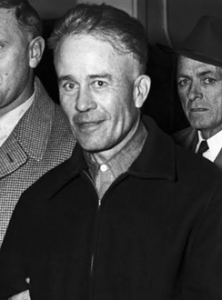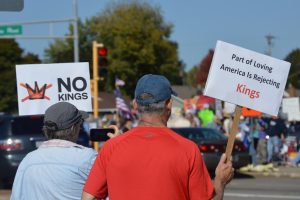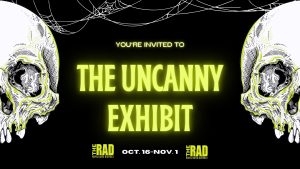Diversity Dialogues Decidedly Didactic

Angela Birrittella (left) and Matt Evenson (right) presenting “Both/And” for UWL’s third annual Social Justice Week.
April 5, 2018
On Wednesday April 4, the words “Both/And” filled a screen in Centennial Hall. Three presenters readied themselves while the audience settled into their desks. The introduction, below the title, read, “How diversity and inclusion initiatives in higher education uphold systems of oppression.”
The first order up for the event doubled as both an icebreaker and an example. Each audience member was given two post-it notes; one red and one yellow. Then, the presenter, Matt Evenson, would say a statement asking for preference, like, “Raise red for cookies, now yellow for brownies.”
This icebreaker consisted of several similar statements choosing between desserts or superheroes, but did the audience have to choose only one? Evenson used this as an example of how we are used to thinking in binaries and not in Both/And.
Both/And thinking was defined during the presentation as “a type of logic used in decision making that allows for a greater variety and scope of outcomes than a rigid either/or decision making process.”
Their slide went on to say, “This approach invites us…to see that more than one reality or perspective can be true at the same time.”
This led Evenson to discuss the difference between Scarcity Thoughts and Abundance Thoughts. “There’s a lot of research to back this up,” he divulged.
Scarcity Thoughts are thinking in terms of mistakes being disasters, the impression that every person is for themselves, or seeing a lack of time to accomplish tasks.
On the other hand, Abundance Thoughts are those of working together, taking time for things that matter, recovering from mistakes, and looking at the abundance of resources available.
The example the presenters provided was that of food insecurity in the United States. A way of solving this problem through Scarcity Thoughts was individuals buying cheaper foods, which tend to be not as healthy, because that’s what they can afford.
An Abundance Thought would be, “All individuals should have equitable access to both affordable and healthy food…” said presenter Megan Pierce.
This led the presenters to discuss the difference between activism and advocacy. Evenson described the difference as, “[Activism is] holding oppressors accountable versus [advocacy being] supporting those oppressed.”
This is when the audience broke off into small groups for an activity involving these terms. The groups were instructed to create a list of groups on campus that they believed were involved in advocacy or activism.
After creating the lists, the presenters turned to their next topic: Mitigating Strategies and Equity Strategies. Mitigating Strategies are more like advocacy; they include supporting students, celebrating diversity, and teaching navigation skills to marginalized groups.
“Why we think Mitigating Strategies are so important is one thing: survival,” said presenter Angela Birrittella. Birrittella shared, “I identify as pansexual, so when I was in college, the LGBTQ Center helped me survive.”
Equity Strategies “rest on the idea that we’re never done learning,” said Evenson. They include strategies such as changing systemic structures of oppression, policy change, liberation, welcoming change, and teaching and supporting activism.
Birrittella added that these are the strategies that can be used to combat the “racist and sexist policies written into the Constitution of UWL.”
The audience was then asked to decide if the organizations and resources they listed were Mitigating or Equity Strategies. While sharing the results, Birrittella noted, “Many Equity Strategies are student-led.”
This led to Pierce reflecting on her own role as an advisor for multicultural students. Pierce wondered aloud, “Why do I feel so gross about this? I wonder if the intent isn’t Equity Strategies? It’s a checkbox…it makes us feel better, it makes me feel better as a white person.”
An audience member interjected that this might be because, “Inclusion for the system is assimilation.”
Birrittella noted that, “There might be some Equity Strategies happening behind the scenes, but if it’s done in secrecy, is it equity?” The final thought was a comment from an audience member, explaining their point of view as a student of color: “I came here to be educated, not be an educator.”





